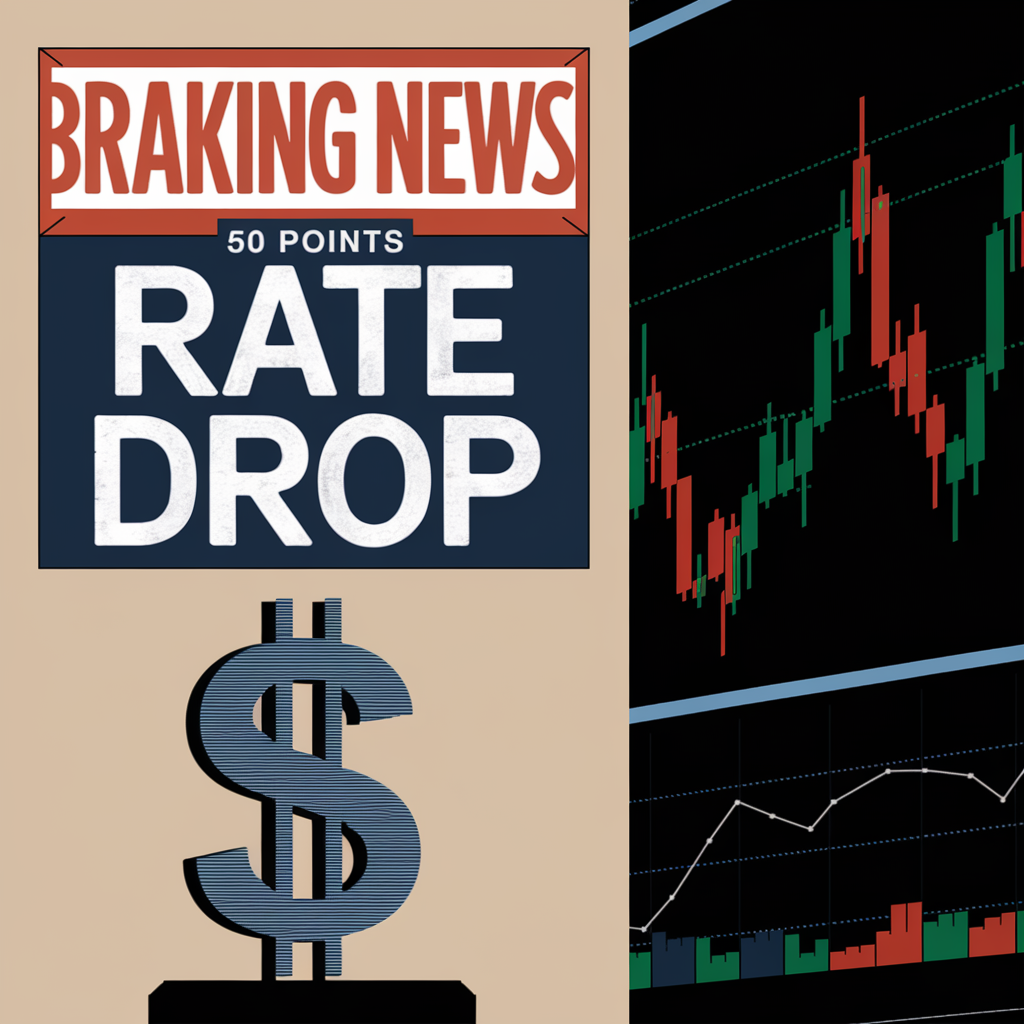In a significant move, the Federal Reserve has announced a 0.5% cut in interest rates, marking the first reduction in over four years. This decision comes amidst growing concerns about rising unemployment and aims to provide relief to borrowers across the nation. As markets react to this unexpected change, it is crucial to understand the implications for various sectors and the broader economy.
Key Takeaways
- The Federal Reserve has reduced interest rates by 0.5%, bringing them to between 4.75% and 5%.
- The cut aims to ease the financial burden on borrowers as inflation shows signs of cooling.
- This is potentially good news for home buyers and could signal a shift in the housing market dynamics. Those with variable rate mortgages may find themselves in a better position to negotiate lower payments or refinance their loans. This shift could also encourage more buyers to enter the housing market, potentially leading to increased competition and rising home prices in the mid term.
- Stock markets reacted positively in an instant before settling down a little, while bond prices shifted in response to the rate change.
- Experts predict that further rate cuts may occur later this year as the economy stabilises.
- The decision has political implications, especially with the upcoming presidential elections.
Immediate Market Reactions to the Fed Rate Cut
Stock Market Response
The announcement of a 0.5% interest rate cut by the Federal Reserve sent shockwaves through the USA markets. Investors reacted swiftly, with many anticipating this move. Wall Street, which had been on edge, saw a mix of gains and losses as traders adjusted their positions.
- The Dow Jones Industrial Average fluctuated, reflecting uncertainty.
- The S&P 500 index showed slight declines, indicating cautious sentiment.
- Fluctuations in stock prices are normal with any change and the next few days and weeks will likely see increased volatility in the market. Investors should prepare for potential shifts in trends, as economic indicators continue to evolve.
- There is a potential for small cap stock to begin to rally due to the lower costs of borrowing. This could lead to increased investor interest and a more favorable environment for growth.
Bond Market Movements
In the bond market, yields dropped significantly as investors sought safety.
- Short-term Treasury yields fell, reflecting expectations of lower rates in the future.
- Long-term bonds also saw increased demand, pushing prices up.
- This shift indicates a strong belief that the Fed’s actions will lead to a more stable economic environment.
Currency Exchange Rates
The currency markets reacted with volatility.
- The US dollar weakened against major currencies, as traders adjusted their expectations.
- This decline in the dollar’s value could lead to increased costs for imports, affecting consumers.
- Overall, the Fed’s decision has created a ripple effect across global markets, with many watching closely for further developments.
The Fed’s decision marks a significant shift in monetary policy, with potential long-term implications for the economy.
Reasons Behind the Fed’s Decision
Inflation Trends
The Federal Reserve’s decision to cut interest rates is largely influenced by inflation trends. After a period of rising prices, inflation has recently shown signs of stabilising. The latest figures indicate that inflation has dropped to 2.5%, the lowest since February 2021. This shift has led the Fed to reconsider its previous stance on rate hikes.
Unemployment Concerns
Another significant factor is the concern over unemployment. As the job market has cooled, there are fears of a broader economic slowdown. The Fed is under pressure to act, especially as hiring has slowed down sharply. Many analysts believe that the Fed is cutting rates to support job growth and prevent further increases in unemployment.
Global Economic Factors
The Fed’s decision is also shaped by global economic factors. Other central banks around the world, including those in Europe and Canada, have already cut rates. The Fed’s move is seen as a response to these international trends, aiming to keep the US economy competitive and stable in a changing global landscape.
The Fed’s actions are closely watched, as they can influence not just the US economy but also global markets. A rate cut is often viewed as a signal of support for economic growth.
In summary, the Fed’s decision to cut rates is driven by a combination of stabilising inflation, rising unemployment concerns, and the need to align with global economic trends. This multifaceted approach aims to foster a healthier economic environment for all.
Impact on Borrowers and Savers
Mortgage Rates
The recent interest rate cut by the Fed is expected to provide much-needed relief for borrowers. Mortgage rates are likely to decrease, making it cheaper for people to buy homes or refinance existing loans. This could lead to an increase in home purchases as more buyers enter the market.
Credit Card Interest
With lower interest rates, credit card companies may also reduce their rates. This very much depends on the country and conditions. This means that those carrying balances on their cards could see a decrease in their monthly payments. However, it’s important for borrowers to check with their banks to understand how these changes will affect them. For those who do not see reductions, borrowers should consider alternative options, such as negotiating with their credit card companies or exploring balance transfer offers. Additionally, it’s wise to stay informed about market trends and potential changes in interest rates to make the best financial decisions moving forward.
Savings Account Yields
While borrowers may benefit, savers might not be as fortunate. Banks often lower the interest rates on savings accounts when the Fed cuts rates. This means that the returns on savings could diminish, making it less appealing for people to save money in traditional accounts.
The Fed’s decision to cut rates will have a significant impact on both borrowers and savers, creating a mixed bag of outcomes for the economy.
In summary, the Fed’s rate cut will likely lead to lower mortgage and credit card rates, providing relief to borrowers. However, savers may find their interest earnings reduced as banks adjust their rates accordingly. Understanding these changes is crucial for making informed financial decisions.
Historical Context of Fed Rate Cuts
Previous Rate Cuts
The Federal Reserve has a long history of adjusting interest rates to manage the economy. In the past, rate cuts have often followed economic downturns. For instance, during the 2008 financial crisis, the Fed slashed rates to near zero to stimulate growth.
Economic Conditions Leading to Cuts
Several factors can lead to a rate cut:
- High unemployment rates: When many people are out of work, the Fed may lower rates to encourage borrowing and spending.
- Low inflation: If prices are not rising, the Fed might cut rates to boost economic activity.
- Global economic pressures: Events in other countries can also influence the Fed’s decisions.
Comparisons with Other Central Banks
The Fed is not alone in making rate cuts. Other central banks, like those in Europe and Canada, have also reduced rates in response to similar economic conditions. This shows a global trend towards lower interest rates to support economies in distress.
The Fed likes to move slow and steady. It took 11 meetings for the Fed to get from 0% to a high of 5.5%. This careful approach reflects the complexities of managing the economy effectively.
Future Projections and Speculations
Predictions for Further Cuts
Many analysts believe that the Federal Reserve may continue to lower interest rates in the coming months. Some key points include:
- A significant number of market participants expect a 50 basis-point cut to be more likely than a smaller reduction.
- The Fed’s recent actions suggest they are preparing for a series of cuts to support the economy.
Effects on International Markets
The Fed’s decision to cut interest rates by 0.5% can have significant effects on international markets. A lower rate often leads to a weaker dollar, which can make commodities priced in dollars, like oil and gold, more expensive for foreign buyers. This can boost demand for these commodities globally.
Conclusion
In summary, the Federal Reserve’s decision to lower interest rates by 0.5% marks a significant shift in the economic landscape of the United States. This move, the first of its kind in four years, aims to ease the financial burden on borrowers who have faced high rates for an extended period. As the markets react to this news, it will be interesting to observe how they stabilise in the coming hours. The Fed’s actions reflect a growing confidence that inflation is returning to manageable levels, which could lead to further rate cuts in the near future. Overall, this development could provide much-needed relief to many Americans, especially as the country approaches a pivotal election.
Please note that this story is a personal account of news as it is understood and being received. It is not intended as advice and the reader should make any financial decisions based on their own research and judgement. It is essential to consult with a financial advisor before making any significant investments. We make no guarantee as to the accuracy of the information contained in this blog.





